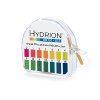Curb Feeler
- 65
- 8
Aren't most of the beneficial bacteria killed by the fertilizers? What about tap water, doesn't that harm them also? How tuff are these guys?
Do the bacteria and microhizzae both live together in these condos, or do they need separate housing because of different requirements? I know they both end up targeting the roots of your plants.
I like the suspended paint bag filter idea. The bene's seem to need lots of air, supended in the air seems a good way to provide it.
I've heard of people using bags of perlite or coco coir and even bags of sponges to do the same thing, provide a home for the bene's.
Do the bacteria and microhizzae both live together in these condos, or do they need separate housing because of different requirements? I know they both end up targeting the roots of your plants.
I like the suspended paint bag filter idea. The bene's seem to need lots of air, supended in the air seems a good way to provide it.
I've heard of people using bags of perlite or coco coir and even bags of sponges to do the same thing, provide a home for the bene's.






